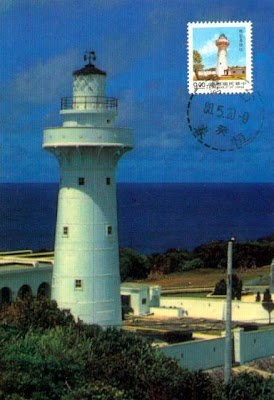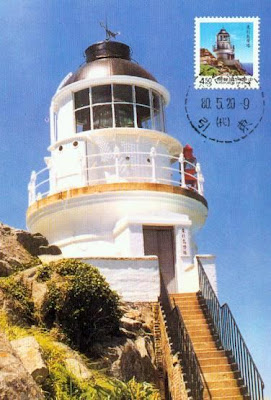skip to main |
skip to sidebar

Stamp Issue : 1991-08-10
Annona squamosa (also called Sugar-apple, or Sweetsop) is a species of Annona native to the tropical Americas. Its exact native range is unknown due to extensive cultivation, but thought to be in the Caribbean; the species was described from Jamaica.
There are also new varieties being developed in Taiwan. There is a pineapple sugar-apple, which is similar in sweetness but has a very different taste. Like the name suggests, it tastes like pineapple. The arrangement of seeds is in spaced rows, with the fruit's flesh filling most of the fruit and making grooves for the seeds, instead of the flesh only occurring around the seeds.

Stamp Issue : 1991-08-10
Mangoes belong to the genus Mangifera, consisting of numerous species of tropical fruiting trees in the flowering plant family Anacardiaceae. The mango is indigenous to the Indian subcontinent and Southeast Asia. Cultivated in many tropical regions and distributed widely in the world, mango is one of the most popularly exploited fruits for food, juice, flavor, fragrance and color. Its leaves are ritually used as floral decorations at weddings and religious ceremonies.

Stamp Issue : 1991-08-10
A grape is the non-climacteric fruit that grows on the perennial and deciduous woody vines of the genus Vitis. Grapes can be eaten raw or used for making jam, juice, jelly, vinegar, wine, grape seed extracts and grape seed oil.

Stamp Issue : 1991-08-10
Strawberries are a common variety of strawberry cultivated worldwide. Like other species of Fragaria, it belongs to the Rosaceae. Technically it is not a fruit although it is known as an accessory fruit, in that the fleshy part is derived not from the plant's ovaries (achenes) but from the peg at the bottom of the bowl-shaped hypanthium that holds the ovaries.

Stamp Issue : 1990-05-19
Dongji Island Lighthouse (東吉嶼燈塔) (Dongji Islet, Penghu County) 23°16′N 119°40′E / 23.267, 119.667

Stamp Issue : 1989-08-16

Stamp Issue : 1991-01-09

Stamp Issue : 1989-08-16
Yuweng Island Lighthouse (漁翁島燈塔) (Yuweng Island, Penghu County) 23°34′N 119°28′E / 23.567, 119.467

Stamp Issue : 1991-05-20

Stamp Issue : 1989-08-16
x

Stamp Issue : 1991-05-20

Stamp Issue : 1990-05-19

Stamp Issue : 1991-01-09

Stamp Issue : 1989-08-06

Stamp Issue : 1989-08-06

Stamp Issue : 1989-04-21

Stamp Issue : 1989-04-21

Stamp Issue : 1991-04-21

Stamp Issue : 1991-12-12

Stamp Issue : 1991-12-12

Stamp Issue : 1991-12-12

Stamp Issue : 1991-12-12

Stamp Issue : 1991-09-12

Stamp Issue : 1991-09-12

Stamp Issue : 1991-09-12

Stamp Issue : 1991-09-12

Stamp Issue : 1991-06-12

Stamp Issue : 1991-06-12

Stamp Issue : 1991-06-12

Stamp Issue : 1991-06-12

Stamp Issue : 1991-03-12

Stamp Issue : 1991-03-12

Stamp Issue : 1991-03-12

Stamp Issue : 1991-03-12

Stamp Issue : 1990-12-17
Hu Shih (1891-1962), born and educated in Shanghai, went to the U.S.A. in 1910 and gained a B.A. from Cornell University and a Ph. D from Columbia. Returning to China in 1917, he served first as professor and then as President of the National Peking University. He was appointed China's wartime Ambassador to the U.S.A. (1938-1942) and President of the Academia Sinica in Taiwan (1958-1962).
Hu Shih is best known as the prime mover of the Chinese Literary Revolution - a movement which aims at the adoption of the living spoken tongue of the people to replace the difficult classical language in literature, writing as well as education.
Hu Shih was the first man to write and publish a volume of poems composed in the spoken language. He also advocated application of the scientific methods in the research of great Chinese classical writings and novels.
His main writings include, Outline of the History of Chinese Philospphy, The Cllected Writings of Hu Shih, History of Spoken Chinese Literature.

Stamp Issue : 1990-10-30
The National Theater and the Concert Hall, situated in the Chiang Kai-shek Memorial Park, Taipei are built in the traditional Chinese palace-style. The main purposes for the establishment of the National Theater and the National Concert Hall are to promote educational and recreational activities for all people, to elevate the standards of the performing arts and to strengthen international exchange and cooperation.

Stamp Issue : 1990-10-30
The National Theater and the Concert Hall, situated in the Chiang Kai-shek Memorial Park, Taipei are built in the traditional Chinese palace-style. The main purposes for the establishment of the National Theater and the National Concert Hall are to promote educational and recreational activities for all people, to elevate the standards of the performing arts and to strengthen international exchange and cooperation.


